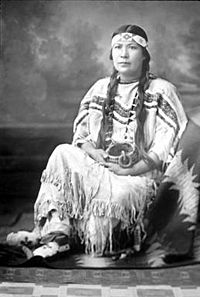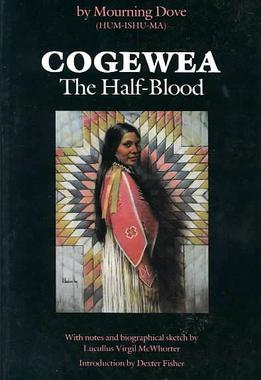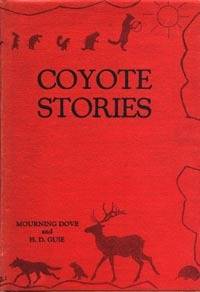Mourning Dove (author) facts for kids
Quick facts for kids
Christine Quintasket
|
|
|---|---|
| Hum-ishu-ma | |

Mourning Dove, c. 1915
|
|
| Okanagan (Syilx), Arrow Lakes (Sinixit), and Colville leader | |
| Personal details | |
| Born | 1884 near Bonners Ferry, Idaho |
| Died | 8 August 1936 Medical Lake, Washington |
| Cause of death | flu |
| Resting place | Omak Memorial Cemetery, WA |
| Spouse | Hector McLeod (Flathead) Fred Galler (Wenatchee) |
| Parent | Joseph Quintasket (father) Lucy Stukin (mother) |
| Known for | Writing books: Cogewea: The Half-Blood (1927) |
| Nickname | Mourning Dove |
Christine Quintasket, also known by her Native name Hum-ishu-ma, was an important Native American author. She is better known by her pen name, Mourning Dove. She belonged to the Okanagan (Syilx), Arrow Lakes (Sinixt), and Colville tribes. She is famous for her 1927 novel Cogewea, the Half-Blood and her 1933 book Coyote Stories.
Cogewea was one of the first novels written by a Native American woman. It was also one of the first to feature a female main character. The story is about Cogewea, a young woman of mixed heritage. Her skills in ranching, riding, and bravery are highly respected by the cowboys on the Flathead Indian Reservation.
Coyote Stories (1933) is a collection of traditional stories. Mourning Dove called them Native American folklore.
Contents
About Mourning Dove's Names
Christine Quintasket was born around 1884. Her father took the surname Quintasket from his stepfather. She also had a Native name, Hum-Ishu-Ma.
When she was young, Christine went to the Sacred Heart School. This school was at the Goodwin Mission near Kettle Falls, Washington. There, she was made to stop speaking her Native language. As a child, she forgot the meaning of her Native name. She thought it meant "Mourning Dove." She first spelled it "Morning Dove" in English. Later, she saw a bird called a mourning dove in a museum. She then changed the spelling of her pen name to 'Mourning' Dove.
However, later in life, she realized her people did not give women bird or animal names. She then said, "The whiteman must have invented the name for it."
Her Early Life and Family
Hum-Ishu-Ma, or Christine Quintasket, was born in April 1888. She was born in a canoe on the Kootenai River near Bonners Ferry, Idaho.
Her mother, Lucy Stukin, had Sinixt (Lakes) and Colville ancestry. Lucy's mother was Sinixt Chief Seewhelken. Her father was a Colville woman. Christine spent a lot of time with her Colville grandmother. Her grandmother taught her many traditional stories.
Christine's father was Joseph Quintasket. He was a mixed-race Okanagan man. His mother was Okanagan, and his father was Irish. Joseph grew up with his mother and stepfather. Christine Quintasket was officially listed as Sinixt (Lakes) on the Colville Indian Reservation. But she felt more connected to her Okanogan heritage. The Okanogan and Sinixt tribes shared similar languages and cultures.
Christine learned English in school. She was inspired to become a writer after reading The Brand: A Tale of the Flathead Reservation. This book was by Theresa Broderick. Christine wanted to correct the negative way Broderick wrote about Native people. Christine's good English skills made her valuable to her community. She advised local Native leaders. She also became involved in Native politics. She helped the Okanogan tribe get money they were owed.
Mourning Dove's Personal Life
Christine Quintasket married Hector McLeod. He was a member of the Flathead people. However, their marriage did not last. In 1919, she married again to Fred Galler of the Wenatchi tribe.
Christine Quintasket passed away on August 8, 1936. She died at the state hospital in Medical Lake, Washington.
Cogewea, the Half-Blood Novel
Mourning Dove's 1927 novel explores a common theme in early Native American stories. This theme is about people of mixed heritage, often called "mixedblood" or "breed." These characters live in both white and Native American cultures. Many mixed-race Native Americans had Native mothers and white fathers. These relationships often began with fur traders or trappers and Native women. Later, other explorers also married Native American women. These marriages created strong connections between tribes and traders.
In the novel, Cogewea has two sisters, Julia and Mary. Their Okanogan mother dies. Their white father then leaves them to join the Klondike Gold Rush in Alaska. Their grandmother, Stemteemä, raises the girls as Okanogan. Julia marries a white rancher. She then takes in her younger sisters at his ranch. This ranch is located within the Flathead Indian Reservation.
Cogewea is courted by two men. One is Alfred Densmore, a white man from the East Coast. The other is James LaGrinder, the mixed-race ranch foreman. Her sisters have different opinions about these men. Julia likes Densmore, but Mary is suspicious of him. In the end, Cogewea and Jim find happiness together.
Working with an Editor
Mourning Dove worked on Cogewea with her editor, Lucullus Virgil McWhorter. He was a white man who studied and supported Native Americans.
Mourning Dove was a new author. She felt that McWhorter changed her book a lot as an editor. In one letter to him, she wrote:
"I have just got through going over the book 'Cogewea,' and am surprised at the changes that you made. I think they are fine... I felt like it was some one else's book and not mine at all. In fact the finishing touches are put there by you, and I have never seen it".
Mourning Dove agreed to the changes. She later wrote to him: "My book of Cogewea would never have been anything but the cheap foolscap paper that it was written on if you had not helped me get it in shape. I can never repay you back."
Cogewea is one of the first novels written by a Native American woman. It was also one of the first Native American novels to feature a female main character. Another early novel was Wynema, a Child of the Forest (1891). This book was by Muscogee (Creek) author Sophia Alice Callahan. It was rediscovered and published again in 1997.
A scholarly edition of Cogewea was published by the University of Nebraska Press in 1981. It is still available today.
Coyote Stories Collection
In 1933, Mourning Dove published Coyote Stories. This book is a collection of legends. Her grandmother and other tribal elders told these stories to her.
The foreword in this book was written by Chief Standing Bear. He wrote: "These legends are of America, as are its mountains, rivers, and forests, and as are its people. They belong!"
Literary Inspirations
Mourning Dove learned how to tell stories from her maternal grandmother. She also learned from Teequalt, an elder who lived with her family. She was also influenced by pulp-fiction novels. Her adopted brother, Jimmy Ryan, let her read these books.
She said the novel The Brand: A Tale of the Flathead Reservation inspired her to write. She wanted to challenge what she felt was a negative portrayal of Native culture in that book.
Mourning Dove's Published Works
- Cogewea: The Half-Blood (1927)
- Coyote Stories (1933) (This book has 27 stories and is 229 pages long.)
- It was also published in Spanish as: Cuentos Indios del Coyote, Paloma Triste (Mourning Dove).
- A shorter English version was published as: Mourning Dove's Stories (117 pages) (1991).
- Tales of the Okanogans (1976)
- Mourning Dove: A Salishan Autobiography (1990)



